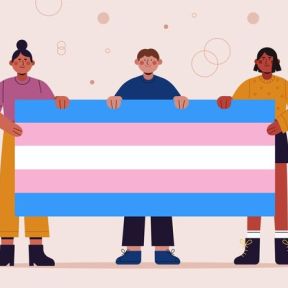
Transgender
People whose gender identity or expression does not conform to the sex they were assigned at birth are transgender. While individuals may be assigned to a sex at birth based on how they present biologically, their sense of their gender may differ. A trans man is a man who was identified as female at birth, and a trans woman is a woman who was identified as male. (Transsexual is an older term that referred to trans individuals who sought or undertook intervention to change their bodies.)
Many trans people, but not all, take steps, either through surgery, hormone treatments, or cosmetic or fashion decisions, to make their bodies and appearances align with their gender identities—the gender with which they identify—whether male-to-female or female-to-male. These steps, which also may include changing one’s name and/or pronouns, are often referred to as transitioning, or as gender affirmation, although the term gender reassignment is used by some. (Cross-dressers, distinct from transgender individuals, generally identify with the gender label they receive at birth but often wear clothing associated with a different gender.)
Gender has increasingly come to be recognized as existing on a continuum. Some people whose self-concept falls outside the traditional binary constructs of male and female, for example, identify as genderqueer. Others living outside of these binary constructs may identify as nonbinary, gender-nonconforming or third gender. These individuals may or may not also identify as transgender.

Any person who identifies differently from the gender they were assigned at birth is transgender. There is no single source of transgender identity. Biological and genetic factors may play a role before a person is born, but personal experiences, in childhood, adolescence, or beyond, may also contribute to one’s gender identity, or at least to one’s awareness of it and comfort disclosing it.
The Williams Institute at the UCLA School of Law estimates that there are 1.4 million adults in the U.S. who identify as transgender, representing 0.7 percent of people between ages 18 and 24 and 0.5 percent of those older than 65. Other experts believe the actual number of trans Americans may be closer to 2 million. The Williams Institute also estimates that 150,000 U.S. residents between ages 13 and 17 are transgender.
Beginning as early as childhood, a transgender person may have feelings of disconnection between their primary and secondary sex traits and designated gender and the gender with which they identify. People who experience intense, persistent gender incongruence, according to the Diagnostic and Statistical Manual of Mental Disorders (DSM-5), may receive a diagnosis of gender dysphoria. It’s a diagnosis that has been widely debated in the psychological and transgender communities because many see it as unnecessarily pathologizing of trans people, although getting a diagnosis can help some individuals access mental health care, and insurance coverage, they might otherwise not be able to take advantage of.
While some children who experience such feelings do not go on to identify as transgender in adulthood, long-standing gender dysphoria is a common experience among adults who do identify as transgender.
For more, see Gender Dysphoria.
No, but many do. Transitioning, or gender affirmation, is a complex process, one that begins not with medical procedures but with expressing one's identity, to themselves and to others with whom they feel safe. Reaching out to transgender community groups, or meeting with a mental health professional who provides affirmative care for transgender people are often among the first steps in the process.
Different individuals follow different paths to gender affirmation: Some may change their name or pronouns, and/or change their clothing or appearance in nonmedical ways, while others will seek hormone therapy treatments and surgical procedures, often at significant expense, that modify their body to conform with their gender identity.
They may be. An individual’s gender or gender identity does not determine their sexual orientation. Trans people, like any other individuals, may be heterosexual, homosexual, bisexual, asexual, or none of the above. Trans people commonly refer to their sexual orientation in terms of their gender identity: For example, a trans woman attracted to women would most likely consider herself to be a lesbian or gay woman.
They can, but they often don’t, in part because of persistent transphobia and resistance to such pairings among the heterosexual, cisgender population. For example, in one recent study, less than 3 percent of heterosexual cisgender people said they would consider dating a trans individual, while 12 percent of nontransgender gay men, 29 percent of nontransgender lesbians, and slightly more than half of people who identified as bisexual, queer, or nonbinary, reported that they would.
No. Despite past misconceptions and persistent myths, being trans is not a mental health disorder. Mental health conditions by definition cause individuals significant distress or disability, while for trans people, affirmation of their identity is often a source of relief. However, many people struggling with expressing their gender identity, or facing discrimination, rejection, obstacles, or abuse because of it, may become depressed or anxious, or experience suicidal ideation. It is important that they seek out therapy or treatment from a mental health professional.
Transgender awareness has grown in recent years, especially as more trans people have become prominent in pop culture and as more young people speak out about their identities at earlier ages than trans people in earlier generations may have. According to one survey, 62 percent of adults in the U.S. now say they support trans rights, as opposed to 29 percent just five years earlier. Today, 30 percent of Americans say they personally know a trans person. But trans individuals still face significant social bias, stigma, abuse, violence, and legal discrimination, as well as a lingering perception based on outdated myths that they are mentally ill, socially deviant, or sexually predatory.
Hate crimes have been frequently perpetuated against members of the transgender community. A majority of trans people report having experienced intimate partner violence, and nearly half report having been sexually assaulted, according to research by advocacy group Human Rights Campaign. Nearly 1 in 10 trans individuals report being physically assaulted each year, and dozens have been violently killed in the U.S. in recent years. Trans people are more likely to live in poverty and without health care than others, in part due to bias that limits their opportunities in the workforce. And trans individuals of racial or ethnic minority backgrounds generally report higher levels of discrimination of all kinds.
In some states, legislatures have supported laws barring trans people from using public bathrooms that correspond with their gender identity or competing in athletic competition against those who share their gender identity. Many anti-discrimination statutes are not written, or have not been updated, to legally protect the civil rights of trans people, although more communities are passing laws or taking other legal actions to affirm the rights or trans individuals.
Use names and pronouns that fit their stated preference and gender. Do not make assumptions, such as about their sexual orientation or that they must be pursuing hormonal or surgical treatments. Learn about trans identity from books, organizations, or trusted websites, and ask questions of a friend or loved on with an open mind. If you are struggling with your own feelings about a partner, parent, child, or close friend expressing a different gender identity, don’t feel ashamed or guilty about it, but do seek support from a mental health professional to help you take steps to maintain your strong relationship.

For many adolescents and young adults, the journey to confidently declaring their gender identity and beginning to live as the gender that suits them ends in positivity, greater self-confidence, and higher self-esteem. But the path to that point often involves intense mental and emotional stress. Questioning one’s own identity, and reckoning with the ramifications of the conclusions, can upend one’s previous beliefs, and re-entering life as a different gender may lead to a loss of friendships and the jeopardizing of family connections, as well as bullying and discrimination, often violent, at school and in the community.
Research suggests that as many as two-thirds of transgender adolescents have had suicidal thoughts, as compared to 13 percent of other teens. But the presence of supportive others in a young transgender person’s life, especially parents, can make a significant difference: For example, 64 percent of transgender teens who felt supported by parents reported having high self-esteem, as opposed to just 13 percent of those who did not.
People can become aware of their transgender identity at any age. Some become conscious of their identity as young children, and many who become aware of it in adolescence or adulthood can look back at early experiences of not feeling that they fit in with others from the gender to which they were assigned at birth.
Many transgender individuals experience not just a sense of discomfort but intense dissatisfaction with their assigned sex or sexual characteristics, or the roles they are expected to play as presumed members of one gender or another. These feelings of gender dissonance can lead to depression and even suicidal ideation without an outlet to share them or support from family or friends. Some quickly and readily embrace their trans identity; others may not find such gender resonance until they encounter others who have had the same experience and with whom they can identify. But at any age, trans people may struggle with their identities, and may experience confusion, shame, or guilt, especially if their family, peer group, or community is not supportive of identities along the gender spectrum.
By not rejecting them or dismissing their statements, but by being affirming and becoming their ally and advocate, in the family, in their school, and if necessary, in the broader community. Some children may appear to be gender non-conforming from an early age, and may experience distress or anxiety about their identity or the expectations placed on them because of what others assume to be their gender; their interactions with peers may be especially stressful.
Parents should not assume, or insist, that these feelings merely represent a “phase,” nor should they encourage or force a child to conform to a gender role that nay not fit their identity. Learning as much as they can about the trans experience, including reading about the experiences of other parents, can be helpful.
By standing with them through their disclosures, medical decisions, and appointments, and by taking everyday steps like using their child’s chosen pronoun, or working with them to choose a new name. Transitioning at a young age may involve harrowing decisions which generally require parental consent, such as considering whether to take medication to block or delay puberty. Becoming informed about the ramifications of such medical decisions, and discussing them openly with a child and their doctor, can help to lessen a young person’s anxiety.
“Rapid-onset” gender dysphoria is a discredited term used by some to describe the apparent phenomenon of young people declaring themselves to be transgender all of a sudden, suggesting that these individuals have been influenced by social media, popular culture, or even peer pressure. The term has been used by some to explain the increased numbers of transgender youth in recent years, particularly in communities where the numbers seem to be unexpectedly high.
However, the 2018 paper on which this theory is based has been widely debunked for, among other reasons, the fact that its survey participants were parents who already believed that their children had changed their gender identity with no previous warning. No actual trans youth were studied to formulate the paper’s conclusions. While the theory has gained traction in some circles and continues to be used to question the sincerity of some transgender youth, the journal that published the paper has published a correction, stating, “Rapid-onset gender dysphoria is not a formal mental health diagnosis at this time. This report did not collect data from the adolescents and young adults (AYAs) or clinicians and therefore does not validate the phenomenon."














